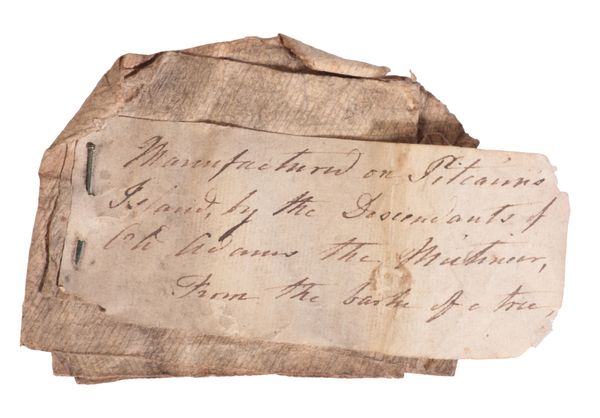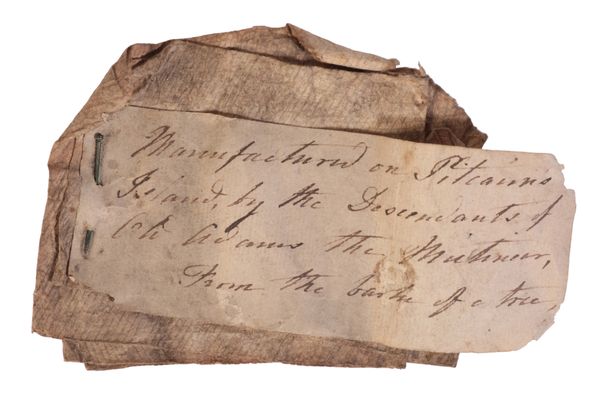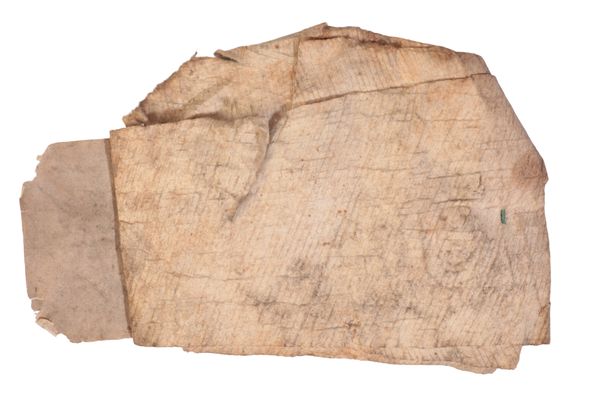“Manufactured on Pitcairn Island, by the descendants of John Adams the mutineer, from the bark of a tree”
Provenance: Private collection, Hampshire
Note: Similar examples can be found in the collection of the British Museum (Oc1937,0308.1 and Oc1937,0308.2) each with the same handwriting as the example offered here, but signed ‘H. Porter’ and dated 1837.
| Estimate: | £5,000 - £10,000 |
John Adams (1767-1829)
John Adams (known as Alexander Smith) was the last survivor of the Bounty Mutineers, the disaffected crewmen, who, led by acting-Lieutenant Fletcher Christian, seized control of the ship from their captain, Lieutenant William Bligh, and set him and eighteen loyalists adrift in the ship’s open launch.
After a sojurn in Tahiti, Christian, the remaining mutineers and some native Tahitians, mainly women forcibly abducted, left on 22nd September 1799 in search of safe haven. He then formed the idea of settling on Pitcairn Island, far to the east of Tahiti; the island had been reported in 1767, but its exact location was never verified. After months of searching, Christian rediscovered the island on 15 January 1790, 188 nautical miles east of its recorded position. This longitudinal error contributed to the mutineers’ decision to settle on Pitcairn in the hope they would be undetected. On arrival the Bounty was unloaded and stripped of most of its masts and spars, for use on the island. It was set ablaze and destroyed on 23rd January 1790.
Although the settlers were able to survive by farming and fishing, the initial period of settlement was marked by serious tensions among the settlers. Alcoholism, murder, disease and other ills had taken the lives of most of the mutineers and Tahitian men. John Adams, Ned Young, and Matthew Quintal were the last three mutineers surviving in 1799 when the thuggish Quintal, while drunk, reportedly threatened to kill the entire community if he could not have Fletcher Christian’s widow as his own consort, and in response Adams and Young lured him to Young’s house and killed him with a hatchet. Having taken effective control of the 19-member strong colony after the 1793 massacre, Adams and Young then turned to the Scriptures using the ship’s Bible as their guide for a new and peaceful society. As a result, Adams and Young embraced Christianity and taught the children to read and write using the Bible. Young eventually died of an asthmatic infection in 1800, but Adams continued his work of educating the women and children. The Pitcairners also converted to Christianity. The Pitcairners would later convert from their existing form of Christianity to Adventism after a successful Adventist mission in the 1890s.
The American sailing ship Topaz was the first to rediscover Pitcairn in 1808. Adams was eventually granted amnesty for the mutiny. On 17 December 1825 Adams was married to Teio, or ‘Mary’. Teio had already borne Adams’ only son, George Adams, in 1804. Adams’ grave on Pitcairn is the only known grave site of a Bounty mutineer. It has a replacement headstone, the original leadcovered wooden grave marker having been taken back to Britain where it is now on display in the National Maritime Museum in Greenwich, London.
The main settlement and capital of Pitcairn, Adamstown, is named after Adams.
Barkcloth
The barkcloth, or ahu in Tahitian, provided the principal material for clothing throughout the Society Islands, and could also be hung ornamentally, used as a partition or as bed-sheets. Barkcloth was produced by women using strips peeled from the soft inner bark of the tree – the Paper Mulberry, Bread-fruit and Fig were used. These strips were then soaked for several days before being beaten together into a continuous sheet using wooden beaters. The finished sheet was left in the sun to bleach, and vegetable dyes could then be pressed into the cloth using leaves and other vegetation to create patterns.



